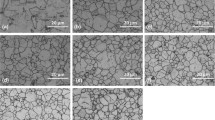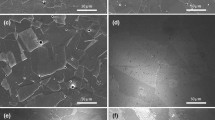Abstract
The evaluation of the degree of sensitization (DOS) to intergranular corrosion (IGC) of a commercial AISI 316L austenitic stainless steel aged at temperatures ranging from 550 °C to 800 °C during 100 to 80,000 hours was carried out using three different assessment methods. (1) The microstructural method coupled with the Strauss standard test (ASTM A262). This method establishes the kinetics of the precipitation phenomenon under different aging conditions, by transmission electronic microscope (TEM) examination of thin foils and electron diffraction. The subsequent chromium-depleted zones are characterized by X-ray microanalysis using scanning transmission electronic microscope (STEM). The superimposition of microstructural time-temperature-precipitation (TTP) and ASTM A262 time-temperature-sensitization (TTS) diagrams provides the relationship between aged microstructure and IGC. Moreover, by considering the chromium-depleted zone characteristics, sensitization and desensitization criteria could be established. (2) The electrochemical method involving the double loop–electrochemical potentiokinetic reactivation (DL-EPR) test. The operating conditions of this test were initially optimized using the experimental design method on the bases of the reliability, the selectivity, and the reproducibility of test responses for both annealed and sensitized steels. The TTS diagram of the AISI 316L stainless steel was established using this method. This diagram offers a quantitative assessment of the DOS and a possibility to appreciate the time-temperature equivalence of the IGC sensitization and desensitization. (3) The analytical method based on the chromium diffusion models. Using the IGC sensitization and desensitization criteria established by the microstructural method, numerical solving of the chromium diffusion equations leads to a calculated AISI 316L TTS diagram. Comparison of these three methods gives a clear advantage to the nondestructive DL-EPR test when it is used with its optimized operating conditions. This quantitative method is simple to perform; it is fast, reliable, economical, and presents the best ability to detect the lowest DOS to IGC. For these reasons, this method can be considered as a serious candidate for IGC checking of stainless steel components of industrial plants.














Similar content being viewed by others
References
V. Cihal, A. Desestret, M. Froment, and G.-H. Wagner: 5th Eur. Conf. on Corrosion, Proc. Conf., Paris, 1973, pp. 249–54
Y. Cetre, P. Eichner, G. Sibaud, and J.M. Scarabello: 3rd Eur. Conf. on Corrosion, Proc. Conf., CEFRACOR, Lyon, France, 1997, pp. C4.1–C4.12
F. Mazaudier, G. Sanchez, and P. Fauvet: 3rd Eur. Conf. on Corrosion, Proc. Conf., CEFRACOR, Lyon, France, 1997, pp. 12.1–12.6
P. Zahumensky, S. Tuleja, J Orszagova, J. Janovec, V. Siladiova: Corr. Sci., 1999, vol. 41, pp. 1305–22
A.P. Majidi, M.A. Streicher: Corr.-Nace, 1984, vol. 40 (11), pp. 584–93
A.P. Majidi, M.A. Streicher: Corr.-Nace, 1984, vol. 40 (9), pp. 445–58
A.P. Majidi, M.A. Streicher: Corr.-Nace, 1984, vol. 40 (8), pp. 393–408
Y.J. Oh, J.H. Yoon, J.H. Hong: Corrosion, 2000, vol. 56 (3), pp. 289–97
S.J. Goodwin, B. Quayle, F.W. Noble: Corr.-Nace, 1987, vol. 43 (12), pp. 743–47
Z. Fang, Y.S. Wu, L. Zhang, J.Q. Li: Corrosion, 1998, vol. 54 (5), pp. 339–46
U. Kamachi Mudali, R.K. Dayal, J.B. Gnanamoorthy, P. Rodriguez: Metall. Mater. Trans. A, 1996, vol. 27A, pp. 2881–87
M. Verneau and B. Bonnefois: 3rd Eur. Conf. on Corrosion, Proc. Conf., CEFRACOR, Lyon, France, 1997, pp. C5.1–C5.6
Y. Jun Oh, J. Hwa Hong: J. Nucl. Mater., 2000, vol. 278, pp. 242–50
D.N. Wasnik, V. Kain, I. Samajdar, B. Verlinden, P.K. De: Acta Mater., 2002, vol. 50, pp. 4587–4601
David L. Reichert, Glenn E. Stoner: J. Electrochem Soc., 1990, vol. 137 (2), pp. 411–13
M.H. Seo, Y.J. Oh, W.S. Ryu, B.S. Chun, J.H. Hong: J. Kor. Inst. Met. Mater., 1998, vol. 36 (6), pp. 918–23
R. Requiz, I. Alvarez: Mater. Sci. Forum, 1998, vols. 289–292 (2), pp. 1007–17
B.S. Covino Jr., S.D. Cramer, J.H. Russell, J.W. Simmons: Corr.-NACE, 1997, vol. 53 (7), pp. 525–36
T. Amadou, C. Braham, H. Sidhom: Metall. Mater. Trans. A, 2004, vol. 35A, pp. 3499–3513
Z. Fang, L. Zhang, Y.S. Wu, J.Q. Li, D.B. Sun, G. Jiang, Z.M. Cui: Corrosion, 1995, vol. 51 (2), pp. 124–30
H. Huang, C. Lui, S. Chen: Corr.-Nace, 1992, vol. 48 (6), pp. 509–13
K.J. Stoner: Proc. Conf. Computer-Aided Microscopy and Metallography, Charlotte, NC, July 25–26, 1989, ASM INTERNATIONAL, Materials Park, OH, 1990, pp. 171–82
H.E. Buhler, L. Gerlach, H. Schlerkmann, W. Schwenk, M. Shoeib: Werkstoffe Korr., 2001, vol. 52, pp. 65–70
W.L. Clarke: General Electric Co. Report No. NUREG/CR-1095, GEAP-248888, R-5, San Jose, CA, 1981, p. 85
ASTM G108, ASTM, New York, NY
NF EN ISO 3651-2, AFNOR, France, 1998
NF EN ISO 3651-1, AFNOR, France, 1998
Practice A262-98: Standard Practices for Detecting Susceptibility to Intergranular Attack in Austenitic Stainless Steels, ASTM, New York, NY, 1998
Test Method G28-97: Standard Test Methods of Detecting Susceptibility to Intergranular Corrosion in Wrought, Nickel-Rich, Chromium-Bearing Alloys, ASTM, New York, NY, 1997
H. Sidhom: Ph.D. Thesis, University of Paris XI, Paris, 1990
H. Sahlaoui: Ph.D. Thesis, University of Tunis El Manar, Tunis, 2003
H. Sahlaoui, H. Sidhom, P. Philibert: Acta Mater., 2002, vol. 50, pp. 1383–92
H. Sahlaoui, K. Maklouf, H. Sidhom, P. Philibert: Mater. Sci. Eng. A, 2004, vol. 372, pp. 98–108
G.S. Was, H.H. Tischner, R.M. Latanision: Metall. Trans. A, 1981, vol. 12A, pp. 1397–1408
Author information
Authors and Affiliations
Corresponding author
Additional information
Manuscript submitted July 24, 2006.
Rights and permissions
About this article
Cite this article
Sidhom, H., Amadou, T., Sahlaoui, H. et al. Quantitative Evaluation of Aged AISI 316L Stainless Steel Sensitization to Intergranular Corrosion: Comparison Between Microstructural Electrochemical and Analytical Methods. Metall Mater Trans A 38, 1269–1280 (2007). https://doi.org/10.1007/s11661-007-9114-9
Received:
Published:
Issue Date:
DOI: https://doi.org/10.1007/s11661-007-9114-9




